In
the May-June, 1998 issue (Vol 40, #3) of the Astrological
Journal (published by the Astrological Association
of England) Theodor Landscheidt presents several
findings regarding the distribution of planets
in birth charts of famous people. One of his findings
is that the angular distance of Mars and Saturn
in the birth charst of 16,800 scientists and physicians
is more often in a golden ratio aspect than would
be expected by chance. Specifically, the following
angles were found to occur more often these charts
than would be expected by chance: 47.5, 55.6, 68.8,
85, 111.2, 137.5, 145.6, 158.8 and 175 degrees.
For an explanation of Landscheidt’s golden
ratio aspects, see the article at http://astrosoftware.com/Reassessment
of the Mars Effect.htm
Although
written over 12 years ago, there appears to be
little follow-up on this study. Landscheidt reports
that the data analyzed was gathered by Mulller
at the University of Cologne in Germany. I added
features to Sirius 1.2 astrology software to enable
me to obtain improved graphs from earlier versions
of Sirius to see how Mars-Saturn angles varied
from the expected distribution in six groups of
professional groups in the Gauquelin data: scientists,
musicians, writers, politicians, military leaders,
and painters. This data is included in Sirius and
I did not attempt to find out if the data collected
by Muller is available. If this data can be obtained
an reanalysis of Muller’s could be performed.
All
six professional groups in the Gauquelin data
have birth dates ranging from the 1790’s
or 1800’s to the 1920’ to 1940’s.
The Sirius software allows the user to produce
a distribution of a planetary angle over any
period of time to represent the random distribution
of the planetary period over that time period.
I found that the specific dates used had little
effect on the distribution as long as a range
of 100 or more years was used. I used a range
of 1800 to 1930 for this control group in the
analysis. Note that creating a control group
for astrological research is difficult in that
the definition of the population from which the
sample is collected is ambiguous given the uneven
and non-normal distribution of birth dates through
the time period. However, the full distribution
of Mars-Saturn angles for 130 years used represents
the likely distribution if births were equally
spread across this time period and given the
stability of this distribution and the deviations
with very small orbs found in this study as described
below, other definitions of a control group would
very likely produce very similar results.
Shown below in Figure 1 is the random distribution
of Mars-Saturn angles the distribution of the
scientists in the Gauquelin data collection.
Angular distances are rounded to the nearest
degree from 1 to 180. The average percent of
charts at any degree is therefore 100/180, or
0.55. As expected from the much larger number
of charts in the random distribution, the random
distribution represented by the green line fluctuates
less than the distribution of scientists as represented
by the blue line. The random distribution is
based on 130 years x 365 days, or over 47,000
Mars-Saturn calculations.

Figure 1. Distribution of Mars-Saturn angles
in scientists and the random distribution.
To visualize deviations from
the random distribution in another way, a graph
of the percent difference between the scientists
and the random distribution is shown in Figure
2 below. 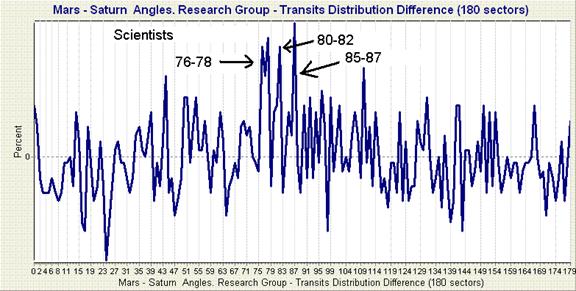
Figure 2. Percent difference of Mars-Saturn angles
in scientists from a random distribution.
The
Sirius software also lists the values for each
degree so that the difference
at each degree is known. Referring to this list,
I noted the degrees that the graph in Figure
2 indicates that the Mars-Saturn angle occurs
more often for scientists than for the random
distribution. These angles are 76-78, 80-82,
and 85-87 degrees. In this exploratory phase
of research hard and fast rules are not used
to determine at which angular distances the scientists
and control group differ but salient peaks are
fairly clear. In general the findings do not
confirm Landscheidt’s finding. The peak
at 85 degrees is confirmed but overall the results
do not closely agree with Landscheidt’s
findings. Of the three peaks identified in the
graph, the peak at 76-78 degrees is most impressive
to me because the graph stays very high across
three degrees whereas the other two peaks extend
for only two degrees and are pronounced only
at a single degree. Note that in the line graph
angular distances vary from 0 to 179 so the range
of 76 to 78 degrees is actually a range of greater
than or equal 76 to less than 79 degrees. Interestingly,
a 3/14 aspect is 77.14 degrees and therefore
is approximately in the middle of this range.
In earlier research it was found that 14th harmonic
aspects involving Saturn are more likely in the
charts of scientists in the Gauquelin data (see
http://astrosoftware.com/DISCOVERY.HTM) . The
current findings suggest that it may be especially
the 3/14 aspect that is important for scientists.
Shown in Figure 3, Figure 4, Figure 5, Figure
6, and Figure 7 are the percent difference in
the charts of the other five professional groups
in the Gauquelin data.

Figure 3. Percent difference of Mars-Saturn angles
in musicians from a random distribution.
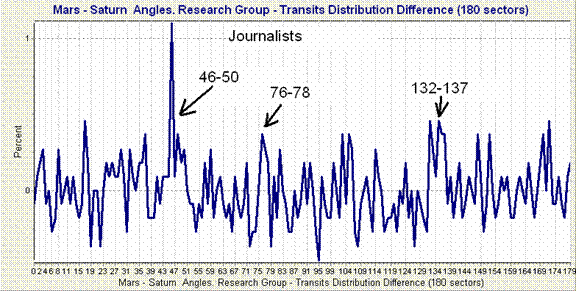
Figure 4. Percent difference of Mars-Saturn angles
in writers and journalists from a random distribution.
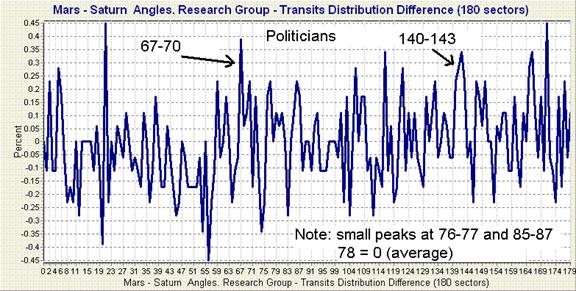
Figure 5. Percent difference of Mars-Saturn angles
in politicians from a random distribution.
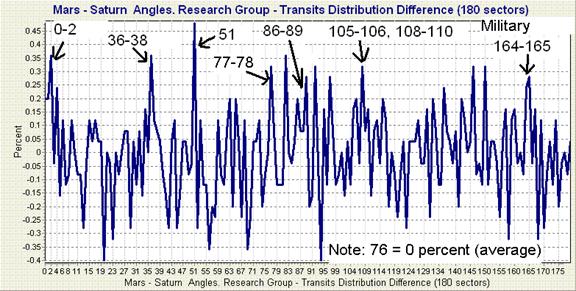
Figure 6. Percent difference of Mars-Saturn angles
in military leaders from a random distribution.
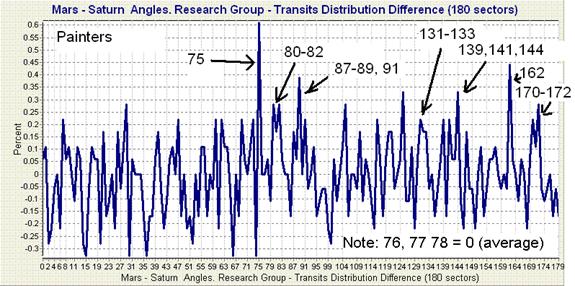
Figure 7. Percent difference of Mars-Saturn angles
in painters from a random distribution.
Interestingly, four of the six
professional groups have above average Mars-Saturn
angles in the 76-78 degree range, which as mentioned
above, is a 3/14 aspect. Painters have average
scores in this range, and musicians have a dramatic
decrease at 77 (which is 77 to 78 degrees), the
center of these 3 degrees. These findings are
difficult to interpret, but may be fairly consistent
with the early study of the Gauquelin data (http://astrosoftware.com/DISCOVERY.HTM)
which found that harmonics based on 11 occur
more often in the charts of musicians. The 11-based
harmonics are hypothesized to promote dynamic
movement and restlessness. Music may be a natural
outlet for people with this restless energy.
The 3/14 aspect might represent a quiet and focused
energy, almost a stillness. We can imagine children
who become very restless thinking about an algebra
problem and those who can focus on it very quietly
and intently. Nevertheless, achieving excellence
in music would presumably require great focus
of energies as well but the dynamic movement
involved in this concentrated activity may be
qualitatively different than in studying science,
for example. However, painters have an average
distribution of Mars-Saturn at the 3/14 aspect,
and one might imagine that painting would benefit
from concentration as well. In short, the findings
support the idea that some 14th harmonic aspects
are important in science, as found in the previous
study, and that the 3/14 aspect perhaps promotes
quiet and still focused concentration. However,
the findings are not unambiguous and may also
be random fluctuations that do not represent
a consistent astrological variable.
Other
researchers may be able to notice other interesting
details in these graphs. For the
present time I am content to conclude that this
study does not confirm the golden ratio aspects
but does suggest that particular angular relationships
based on harmonics may occur at measurable levels
in individuals whose behavior can be distinguished
from a random group. As Landscheidt pointed out,
if there is validity to the astrological proposition
that human behavior is associated with the angular
distance between planets, the angular relationship
is not likely to be in simple fractions of the
circle as as ½, 1/3. ¼, etc. as
most often used by astrologers.
A great amount of additional exploratory research
along these lines can be conducted. Using measurements
in right ascension and direct distance rather
than in zodiac longitude, heliocentric positions,
and the analysis of other planets besides Mars
and Saturn are among some of the most obvious
possible avenues for future research.
As
noted earlier, Landscheidt’s study,
despite the very promising findings which he
presents, appears to have remained dormant for
over a decade. Perhaps the lack of funding for
astrological research and a lack of motivation
and interest in this kind of research by astrologers
are contributing factors. I suggest that even
negative findings are important because the findings
provide information regarding the limits of astrological
information. At astrological conferences and
discussion groups many astrologers voice their
disinterest in scientific research in astrology,
but even if skeptics within the field of astrology
and outside the field of astrology are correct,
confirming to what extent astrology may produce
measurable results is an important contribution
to our understanding of a mysterious subject
that continues to be used and supported by a
great many people despite its status as a largely
fringe subject outside mainstream academia.
As often seems to be the case, the results
are intriguing but very far from a validation
of astrological principles. I conclude that if
astrology is capable of producing measurable
results, we have yet to identify a formula for
doing so and if a measurable effect of astrology
is found, it is not likely to conform to the
analytical procedures typically used by astrologers. |
![]() Copyright © Cosmic
Patterns. All Rights Reserved Created
Copyright © Cosmic
Patterns. All Rights Reserved Created